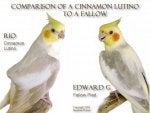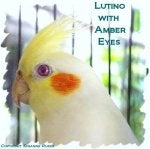I have put a deposit on a baby 'albino' cockatiel who is being hand reared by a near by breeder. Is this mutation more susceptible to blindness or poor vision?

uki09
83 posts
·
Joined 2009
Don't quote me as I might be wrong but I seem to recall reading somewhere that lutino's in general are more susceptible to "night frights" then other types of cockatiels due to the lack of pigment in the eye. They also see things differently in low light situations and this can cause them to freak out more so then non lutino cockatiels.
As for blindness I guess it could be a possibility if you're leaving them out all day every day in bright sun with no shade.
As for blindness I guess it could be a possibility if you're leaving them out all day every day in bright sun with no shade.
610 posts
·
Joined 2008
Before I sold my lutino, Gracie, she had numerous night frights, but all the others never had one. Still, M&M and Ollie have never had one either...I am not sure if it was because she was lutino, but I always wondered if it was because of that.Don't quote me as I might be wrong but I seem to recall reading somewhere that lutino's in general are more susceptible to "night frights" then other types of cockatiels due to the lack of pigment in the eye.
4,850 posts
·
Joined 2007
I've had lutinos and they were no different then any other mutation I have. the only ones that have night freights are the young ones just being put in the bird room because it is all new to them , occasionally the adults do but I know what causes them all (there is a jerk who drives by all hours of the night with his stereo blasting and i can hear it in my room and I'm at the other end of the house away from the road
and my lutinos haven't had any eye problems.
and my lutinos haven't had any eye problems.
268 posts
·
Joined 2009
that is a myth...from ancient times people have been saying Albino (fill in the mammel, reptile, etc) are blind, when in fact science has proven otherwise.
They get eaten in the wild sooner because they are so visible to predators, not from being blind.
we have a couple Lutinos, they have never had night frights, but the other birds sure do

They get eaten in the wild sooner because they are so visible to predators, not from being blind.
we have a couple Lutinos, they have never had night frights, but the other birds sure do
10,937 posts
·
Joined 2008
According to the American Cockatiel Society at http://www.acstiels.com/Articles/Genetics/gen3.html the following are old wives tales:
"breeding two silvers together produce blind chicks; breeding pairs of Lutinos, Whiteface or Silvers together produce weak chicks, you can sex young birds by feeling the pelvic bones. These have all been proven false"
They don't specifically mention blindness in whiteface lutinos (aka albino) but it seems to fit the pattern of the other myths. However it's widely recommended to not breed two lutinos together so I'm not convinced that they're right to call it a myth.
"breeding two silvers together produce blind chicks; breeding pairs of Lutinos, Whiteface or Silvers together produce weak chicks, you can sex young birds by feeling the pelvic bones. These have all been proven false"
They don't specifically mention blindness in whiteface lutinos (aka albino) but it seems to fit the pattern of the other myths. However it's widely recommended to not breed two lutinos together so I'm not convinced that they're right to call it a myth.
4,850 posts
·
Joined 2007
but your not supposed to breed 2 lutinos because of the notorious bald spot, has nothing to do with the eye sight
9,101 posts
·
Joined 2009
Not neccessarily so. Knowing the background of the lutino helps. If each came from a visual to a split, then visusal to visual is fine for the next generation...then the next generation visual to split. In otherwords alternate a visual or a split each generation.
Other qualities have to be taken into consideration. Size, conformation, head feather quality and splits. Pearl enhances (brings out) baldness, and pied helps to improve head feather quality.
Also if a lutino is of good quality, good confirmation, and other good traits, yet has the bald spot, yes you can breed it...but to a good quality non-lutino bird (preferrably a pied) for splits carrying the lutino gene, and the next generation of lutinos headfeathering will be improved.
Pairing two poor quality or bald lutinos tends to produce the same, though every once in awhile you can get a beautiful full head feathered bird.
And ANY lutino, even after generations of working out the baldness and working with alternate generations of splits can still produce bald or thinly feathered heads/crests.
The blindness and vision problems with the current mutations silvers, lutinos and red eyed birds is BULL CRAP. Some of this may have occurred during the early development of the color mutations, but they were also breeding closely related birds to produce more visuals. These mutations have been firmly established now and bloodlines have been out-crossed to improve the mutations.
Other qualities have to be taken into consideration. Size, conformation, head feather quality and splits. Pearl enhances (brings out) baldness, and pied helps to improve head feather quality.
Also if a lutino is of good quality, good confirmation, and other good traits, yet has the bald spot, yes you can breed it...but to a good quality non-lutino bird (preferrably a pied) for splits carrying the lutino gene, and the next generation of lutinos headfeathering will be improved.
Pairing two poor quality or bald lutinos tends to produce the same, though every once in awhile you can get a beautiful full head feathered bird.
And ANY lutino, even after generations of working out the baldness and working with alternate generations of splits can still produce bald or thinly feathered heads/crests.
The blindness and vision problems with the current mutations silvers, lutinos and red eyed birds is BULL CRAP. Some of this may have occurred during the early development of the color mutations, but they were also breeding closely related birds to produce more visuals. These mutations have been firmly established now and bloodlines have been out-crossed to improve the mutations.
290 posts
·
Joined 2009
Angel is a 3 year old wf lutino (albino some call it) She has the odd night fright but many tiels do. She has excellent vision. I am aware though of sensitivity in the eyes of an albino friend with sunlight so when my birds are in the sun cage and out with me I am sure to provide some shade with a towel over part of the cage for them. Something that should be done anyway. She chooses where to sit and is in sun or shade about 50 50 of the time.
10,937 posts
·
Joined 2008
I've read that too much sun can damage the eyes of red-eyed birds because they don't have the melanin protection that dark-eyed birds have. According to Wikipedia there are quite a few eye problems associated with albinism - see http://en.wikipedia.org/wiki/Albinism#Symptoms_and_conditions_associated_with_albinism This is a general discussion that isn't about any particular species, so I don't know if there are any special rules or exceptions for birds.I do remember someone saying that Lutinos/Albinos shouldn't be left in the sun for too long?
9,101 posts
·
Joined 2009
Hmmmm...my birds are housed outside...and the FL sun is bright, and I have several red-eyed birds and I have never noticed that this damaged their eyes. I have noticed though when pied is also bred to lutino they are less prone to night frights, and baldness. But the poed can affect the eye and by a year old the iris can turn amber or blue, which is very striking on a lutino.
9,101 posts
·
Joined 2009
Rhe first pix is Rio...a Cinnamon lutino, and he had beautiful amber eyes. When he was a baby he looked like a normal lutino, and after a year old the eye color changed and his color was prettier than in the pix...he actually looked a pinkish tan. Everyone wanted the pink bird in the flight...LOL
The 2nd pix is of a lutino split to pied and WF. Again normal lutino eyes when young. I can't find my blue eyed lutino pix's. They are more a white-blue color.
The 2nd pix is of a lutino split to pied and WF. Again normal lutino eyes when young. I can't find my blue eyed lutino pix's. They are more a white-blue color.
Attachments
-
51.6 KB Views: 817
-
49.6 KB Views: 763
46 posts
·
Joined 2009
That lutino split pied has big eyes. thank you for shring, very nice. Too bad you don't have the blue eyed piture, I bet that was pretty.
9,101 posts
·
Joined 2009
Thanks...I love big eyes. Here is a baby I'm handfeeding now and it's name is 'Big Eye'
Attachments
-
59.3 KB Views: 375
9,101 posts
·
Joined 2009
Silverflower...while on the forum homepage there was a pix at the top that had an interesting lutino with blue eyes: http://talkcockatiels.com/photoplog/index.php?n=759
46 posts
·
Joined 2009
Thank you, I looked at it and it is pretty, a litle strange, but cool! Also your Double factor dominate silver, is very pretty, and I agree big eye is agood name for it. I haven't seen any of those birds, the ones I have seen out here looked normal to me, but they said they were single factor dominate silver. The feathers look so neat, thank you for showing it to me.
9,101 posts
·
Joined 2009
Thanks!...Big Eye is my first (in a long time) Double factor baby. I work mainly with single factor (SF), and have started getting very light toned SF
Attachments
-
89.6 KB Views: 287
7 posts
·
Joined 2009
I have a whiteface named dusty and night frights are a common thing sometimes even have to put him in a different cage of a night to the rest due to injurying his wings.lucy my lutino has a had a few.But they are a beautiful cockatiel to own.I find a diet of pellets help with the wings and feather injurys
290 posts
·
Joined 2009
I have a clear fall area under where she perches at night in my cage, which is 4ft internally high. Mine benefits from a night light and being uncovered. Some prefer to be covered.
716 posts
·
Joined 2009
Our two have never had nightfrights, in nearly a year of us owning them. They sleep covered and uncovered, with and without a nightlight, and it makes no difference to them. Ours are both heavily pied females. I think some birds are just more susceptable to them.
-
?
-
?
-
?
-
?
-
?
-
?
-
?
-
?
-
?
-
?
-
?
-
?
-
?
-
?
-
?
-
?
-
?
-
?
-
?
-
?
- posts
- 514K
- members
- 26K
- Since
- 2007
A forum community dedicated to Cockatiel owners and enthusiasts. Come join the discussion about breeding, health, feeding, behavior, housing, adopting, care, classifieds, and more!
Top Contributors this Month
View All
tielz
8 Replies
pmfrizzle77
8 Replies
kathyaraujo1429
5 Replies







